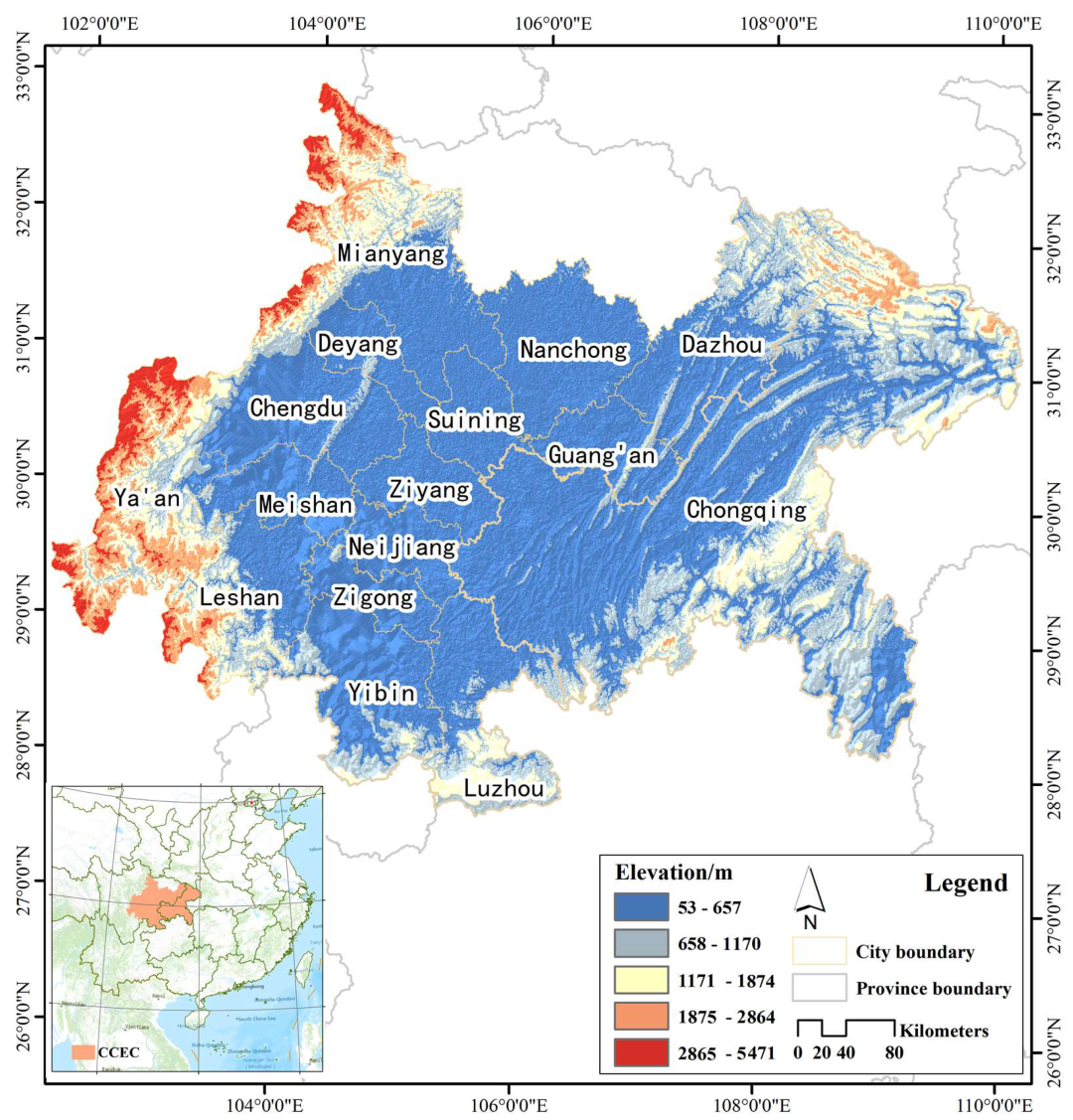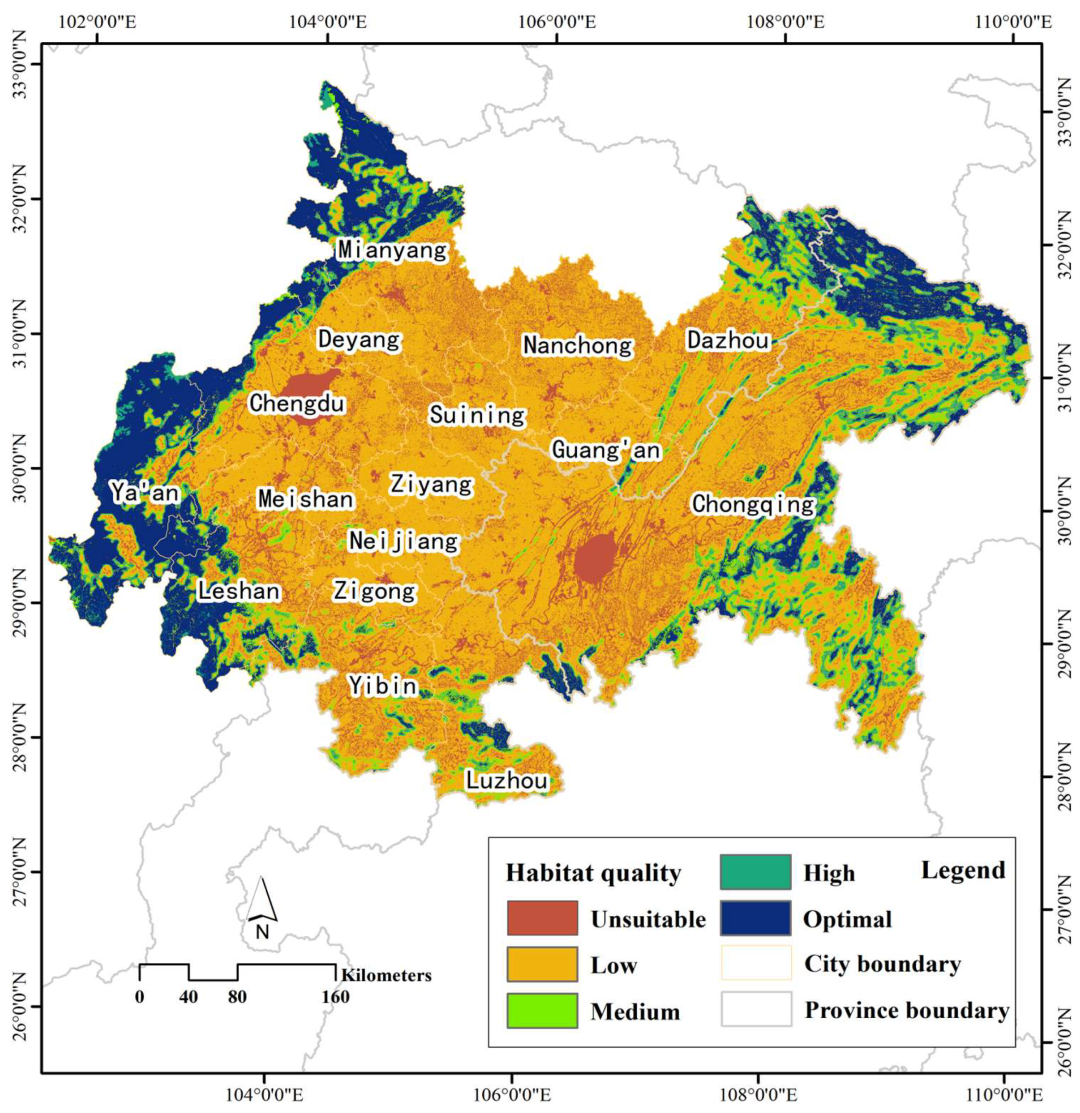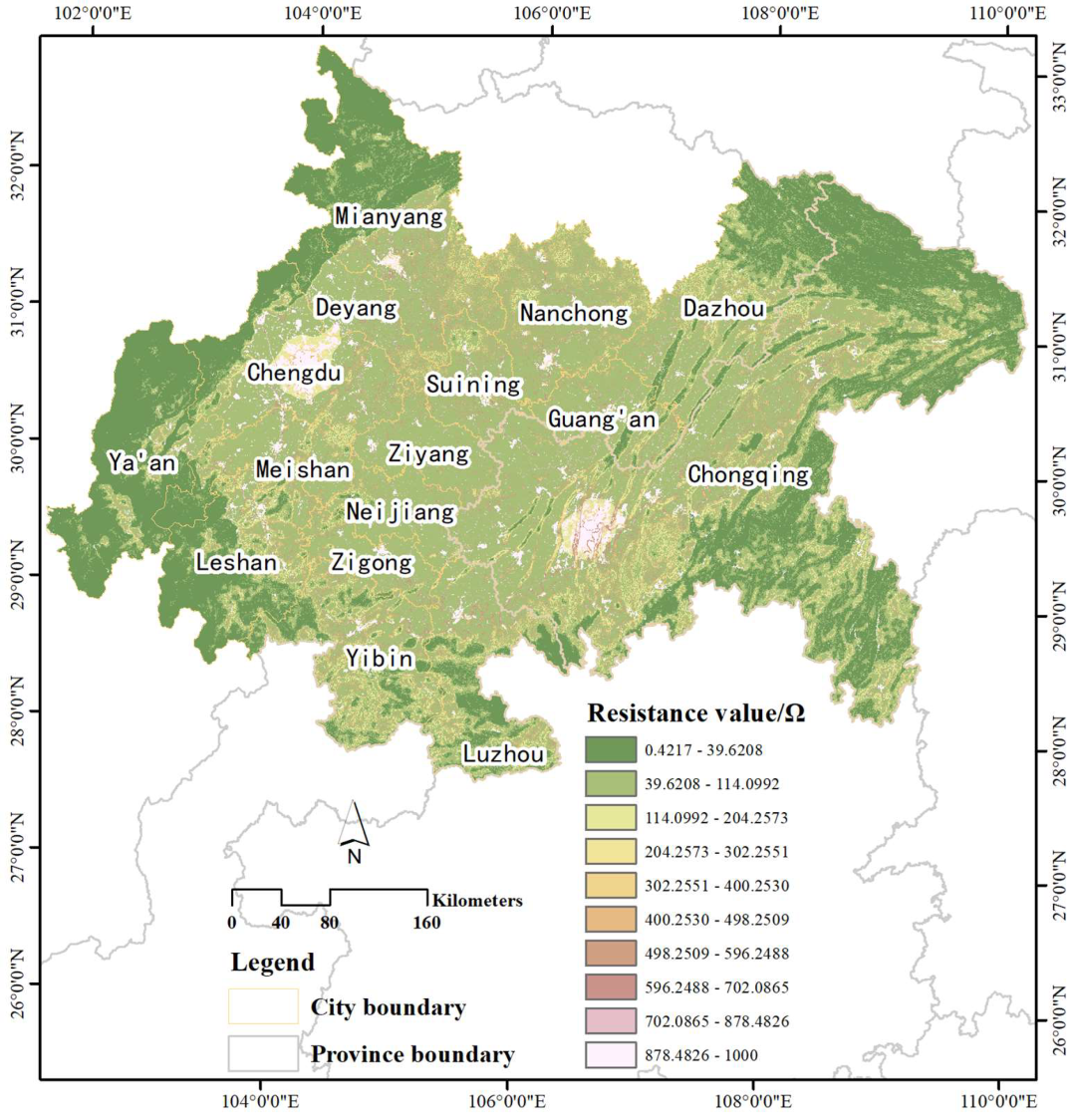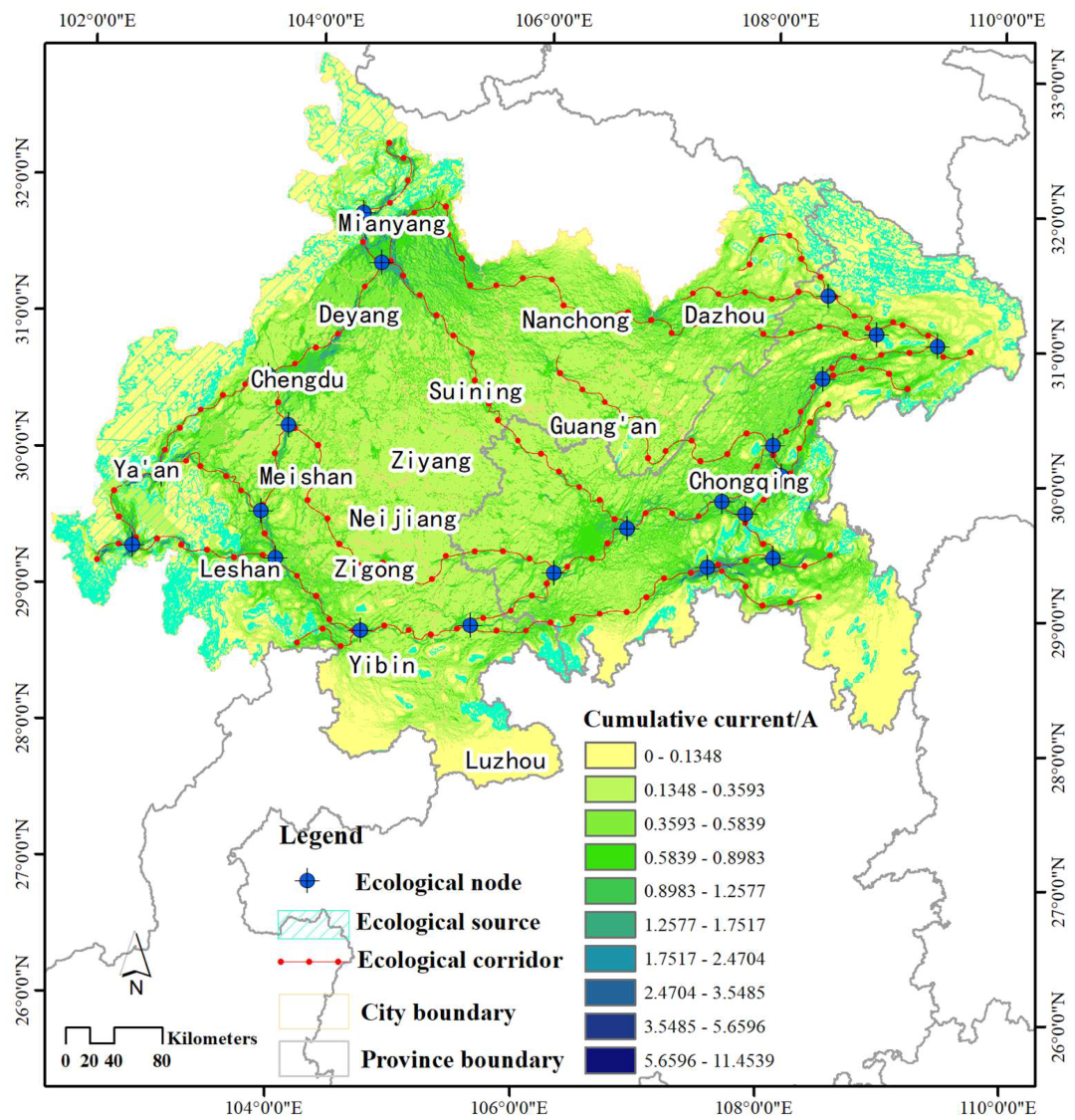Ecological Security Patterns Research Based on Ecosystem Services and Circuit Theory in Southwest China
Abstract
1. Introduction
2. Materials and Methods
2.1. Study Area
2.2. Data Sources
2.3. Habitat Quality Assessment
2.4. Ecological Sources
2.5. Ecological Resistance Surface
2.6. Ecological Corridors
3. Results
3.1. Spatial Variation of Habitat Quality
3.2. Spatial Distribution Characteristics of Habitat Landscape Resistance, Ecological Sources, and Landscape Connectivity
3.3. Characteristics of the Ecological Security Patterns
4. Discussion
5. Conclusions
Supplementary Materials
Author Contributions
Funding
Institutional Review Board Statement
Informed Consent Statement
Data Availability Statement
Conflicts of Interest
References
- Feng, W.; Liu, Y.; Qu, L. Effect of land-centered urbanization on rural development: A regional analysis in China. Land Use Policy 2019, 87, 104072. [Google Scholar] [CrossRef]
- Wanghe, K.; Guo, X.; Wang, M.; Zhuang, H.; Ahmad, S.; Khan, T.U.; Li, K. Gravity model toolbox: An automated and open-source ArcGIS tool to build and prioritize ecological corridors in urban landscapes. Glob. Ecol. Conserv. 2020, 22, e01012. [Google Scholar] [CrossRef]
- Feist, B.E.; Buhle, E.R.; Baldwin, D.H.; Spromberg, J.A.; Damm, S.E.; Davis, J.W.; Scholz, N.L. Roads to ruin: Conservation threats to a sentinel species across an urban gradient. Ecol. Appl. 2017, 27, 2382–2396. [Google Scholar] [CrossRef] [PubMed]
- Peng, J.; Yang, Y.; Liu, Y.; Du, Y.; Meersmans, J.; Qiu, S. Linking ecosystem services and circuit theory to identify ecological security patterns. Sci. Total Environ. 2018, 644, 781–790. [Google Scholar] [CrossRef]
- Dong, L.; Liu, J.; Du, X.; Dai, C.; Liu, R. Simulation-based risk analysis of water pollution accidents combining multi-stressors and multi-receptors in a coastal watershed. Ecol. Indic. 2018, 92, 161–170. [Google Scholar] [CrossRef]
- Teixeira, L.; Tisovec-Dufner, K.C.; Marin GD, L.; Marchini, S.; Dorresteijn, I.; Pardini, R. Linking human and ecological components to understand human–wildlife conflicts across landscapes and species. Conserv. Biol. 2021, 35, 285–296. [Google Scholar] [CrossRef]
- McCarty, J.P. Ecological consequences of recent climate change. Conserv. Biol. 2001, 15, 320–331. [Google Scholar] [CrossRef]
- Díaz, S.; Fargione, J.; Chapin, F.S., III; Tilman, D. Biodiversity loss threatens human well-being. PLoS Biol. 2006, 4, e277. [Google Scholar] [CrossRef]
- Liu, C.; Li, W.; Xu, J.; Zhou, H.; Li, C.; Wang, W. Global trends and characteristics of ecological security research in the early 21st century: A literature review and bibliometric analysis. Ecol. Indic. 2022, 137, 108734. [Google Scholar] [CrossRef]
- Zhang, J.; Zhang, P.; Wang, R.; Liu, Y.; Lu, S. Identifying the coupling coordination relationship between urbanization and forest ecological security and its impact mechanism: Case study of the Yangtze River Economic Belt, China. J. Environ. Manag. 2023, 342, 118327. [Google Scholar] [CrossRef]
- Xiao, S.; Wu, W.; Guo, J.; Ou, M.; Pueppke, S.G.; Ou, W.; Tao, Y. An evaluation framework for designing ecological security patterns and prioritizing ecological corridors: Application in Jiangsu Province, China. Landsc. Ecol. 2020, 35, 2517–2534. [Google Scholar] [CrossRef]
- Esbah, H.; Cook, E.A.; Ewan, J. Effects of increasing urbanization on the ecological integrity of open space preserves. Environ. Manag. 2009, 43, 846–862. [Google Scholar] [CrossRef] [PubMed]
- Peng, J.; Pan, Y.; Liu, Y.; Zhao, H.; Wang, Y. Linking ecological degradation risk to identify ecological security patterns in a rapidly urbanizing landscape. Habitat Int. 2018, 71, 110–124. [Google Scholar] [CrossRef]
- Zhao, Y.Z.; Zou, X.Y.; Cheng, H.; Jia, H.K.; Wu, Y.Q.; Wang, G.Y.; Zhang, C.L.; Gao, S.Y. Assessing the ecological security of the Tibetan plateau: Methodology and a case study for Lhaze County. J. Environ. Manag. 2006, 80, 120–131. [Google Scholar] [CrossRef] [PubMed]
- Huang, J.; Hu, Y.; Zheng, F. Research on recognition and protection of ecological security patterns based on circuit theory: A case study of Jinan City. Environ. Sci. Pollut. Res. 2020, 27, 12414–12427. [Google Scholar] [CrossRef] [PubMed]
- Wang, C.; Yu, C.; Chen, T.; Feng, Z.; Hu, Y.; Wu, K. Can the establishment of ecological security patterns improve ecological protection? An example of Nanchang, China. Sci. Total Environ. 2020, 740, 140051. [Google Scholar] [CrossRef] [PubMed]
- Zhang, L.; Peng, J.; Liu, Y.; Wu, J. Coupling ecosystem services supply and human ecological demand to identify landscape ecological security pattern: A case study in Beijing–Tianjin–Hebei region, China. Urban Ecosyst. 2017, 20, 701–714. [Google Scholar] [CrossRef]
- Guo, R.; Wu, T.; Liu, M.; Huang, M.; Stendardo, L.; Zhang, Y. The construction and optimization of ecological security pattern in the Harbin-Changchun urban agglomeration, China. Int. J. Environ. Res. Public Health 2019, 16, 1190. [Google Scholar] [CrossRef] [PubMed]
- Wanghe, K.; Guo, X.; Luan, X.; Li, K. Assessment of urban green space based on bio-energy landscape connectivity: A case study on Tongzhou district in Beijing, China. Sustainability 2019, 11, 4943. [Google Scholar] [CrossRef]
- Wang, Y.; Pan, J. Building ecological security patterns based on ecosystem services value reconstruction in an arid inland basin: A case study in Ganzhou District, NW China. J. Clean. Prod. 2019, 241, 118337. [Google Scholar] [CrossRef]
- Xu, J.; Fan, F.; Liu, Y.; Dong, J.; Chen, J. Construction of ecological security patterns in nature reserves based on ecosystem services and circuit theory: A case study in Wenchuan, China. Int. J. Environ. Res. Public Health 2019, 16, 3220. [Google Scholar] [CrossRef] [PubMed]
- Liu, Y.; Zhao, C.; Liu, X.; Chang, Y.; Wang, H.; Yang, J.; Yang, X.; Wei, Y. The multi-dimensional perspective of ecological security evaluation and drive mechanism for Baishuijiang National Nature Reserve, China. Ecol. Indic. 2021, 132, 108295. [Google Scholar] [CrossRef]
- Balasooriya BL, W.K.; Samson, R.; Mbikwa, F.; Boeckx, P.; Van Meirvenne, M. Biomonitoring of urban habitat quality by anatomical and chemical leaf characteristics. Environ. Exp. Bot. 2009, 65, 386–394. [Google Scholar] [CrossRef]
- Hirzel, A.H.; Hausser, J.; Chessel, D.; Perrin, N. Ecological-niche factor analysis: How to compute habitat-suitability maps without absence data? Ecology 2002, 83, 2027–2036. [Google Scholar] [CrossRef]
- Nematollahi, S.; Fakheran, S.; Kienast, F.; Jafari, A. Application of InVEST habitat quality module in spatially vulnerability assessment of natural habitats (case study: Chaharmahal and Bakhtiari province, Iran). Environ. Monit. Assess. 2020, 192, 487. [Google Scholar] [CrossRef] [PubMed]
- Dai, Y.; Peng, G.; Wen, C.; Zahoor, B.; Ma, X.; Hacker, C.E.; Xue, Y. Climate and land use changes shift the distribution and dispersal of two umbrella species in the Hindu Kush Himalayan region. Sci. Total Environ. 2021, 777, 146207. [Google Scholar] [CrossRef]
- Sharp, R.; Tallis, H.; Ricketts, T.; Guerry, T.; Wood, S.A. InVEST 3.7.0. The Natural Capital Project; Stanford University: Stanford, CA, USA, 2018. [Google Scholar]
- Zhong, L.; Wang, J. Evaluation on effect of land consolidation on habitat quality based on InVEST model. Trans. Chin. Soc. Agric. Eng. 2017, 33, 250–255. [Google Scholar]
- Huang, J.; Huang, J.; Liu, C.; Zhang, J.; Lu, X.; Ma, K. Diversity hotspots and conservation gaps for the Chinese endemic seed flora. Biol. Conserv. 2016, 198, 104–112. [Google Scholar] [CrossRef]
- Lu, S.; Tang, X.; Guan, X.; Qin, F.; Liu, X.; Zhang, D. The assessment of forest ecological security and its determining indicators: A case study of the Yangtze River Economic Belt in China. J. Environ. Manag. 2020, 258, 110048. [Google Scholar] [CrossRef]
- Li, W.; Wang, Y.; Xie, S.; Cheng, X. Coupling coordination analysis and spatiotemporal heterogeneity between urbanization and ecosystem health in Chongqing municipality, China. Sci. Total Environ. 2021, 791, 148311. [Google Scholar] [CrossRef]
- Chen, J.; Cao, X.; Peng, S.; Ren, H. Analysis and applications of GlobeLand30: A review. ISPRS Int. J. Geo-Inf. 2017, 6, 230. [Google Scholar] [CrossRef]
- Chen, J.; Chen, J.; Liao, A.; Cao, X.; Chen, L.; Chen, X.; He, C.; Han, G.; Peng, M.; Mills, J.; et al. Global land cover mapping at 30 m resolution: A POK-based operational approach. ISPRS J. Photogramm. Remote Sens. 2015, 103, 7–27. [Google Scholar] [CrossRef]
- Sallustio, L.; De Toni, A.; Strollo, A.; Di Febbraro, M.; Gissi, E.; Casella, L.; Geneletti, D.; Munafò, M.; Vizzarri, M.; Marchetti, M. Assessing habitat quality in relation to the spatial distribution of protected areas in Italy. J. Environ. Manag. 2017, 201, 129–137. [Google Scholar] [CrossRef] [PubMed]
- Nelson, E.; Mendoza, G.; Regetz, J.; Polasky, S.; Tallis, H.; Cameron, D.; Chan, K.M.; Daily, G.C.; Goldstein, J.; Shaw, M.; et al. Modeling multiple ecosystem services, biodiversity conservation, commodity production, and tradeoffs at landscape scales. Front. Ecol. Environ. 2009, 7, 4–11. [Google Scholar] [CrossRef]
- Qiu, J.; Turner, M.G. Spatial interactions among ecosystem services in an urbanizing agricultural watershed. Proc. Natl. Acad. Sci. USA 2013, 110, 12149–12154. [Google Scholar] [CrossRef] [PubMed]
- Zheng, Q.; Shen, M.; Zhong, L. Construction of ecological security pattern in Pudacuo National Park. Acta Ecol. Sin. 2021, 41, 874–885. [Google Scholar]
- Li, C.; Wang, J.; Liu, X.; Xu, K. Construction of Karst Landscape Ecological Security Pattern Based on Conflict between Human and Nature in Puzhehei. Sustainability 2024, 16, 908. [Google Scholar] [CrossRef]
- Adriaensen, F.; Chardon, J.P.; De Blust, G.; Swinnen, E.; Villalba, S.; Gulinck, H.; Matthysen, E. The application of ‘least-cost’modelling as a functional landscape model. Landsc. Urban Plan. 2003, 64, 233–247. [Google Scholar] [CrossRef]
- McRae, B.H.; Dickson, B.G.; Keitt, T.H.; Shah, V.B. Using circuit theory to model connectivity in ecology, evolution, and conservation. Ecology 2008, 89, 2712–2724. [Google Scholar] [CrossRef]
- Li, J.; Xu, J.; Chu, J. The construction of a regional ecological security pattern based on circuit theory. Sustainability 2019, 11, 6343. [Google Scholar] [CrossRef]
- Du, L.; Hou, Y.; Zhong, S.; Qu, K. Identification of Priority Areas for Ecological Restoration in Coal Mining Areas with a High Groundwater Table Based on Ecological Security Pattern and Ecological Vulnerability. Sustainability 2023, 16, 159. [Google Scholar] [CrossRef]
- Williams, J.C.; Snyder, S.A. Restoring habitat corridors in fragmented landscapes using optimization and percolation models. Environ. Model. Assess. 2005, 10, 239–250. [Google Scholar] [CrossRef]




| Administrative Area | Unsuitable Habitat/km2 | Suitable Habitat/km2 | The Proportion of the Administrative Area Occupied by Optimal Habitat/% | |||
|---|---|---|---|---|---|---|
| Low | Medium | High | Optimal | |||
| Ya’an | 282.59 | 2743.90 | 904.16 | 1829.44 | 9286.43 | 61.72 |
| Mianyang | 1957.30 | 8810.86 | 903.19 | 1725.27 | 6803.88 | 33.68 |
| Leshan | 1227.95 | 5363.76 | 1278.16 | 858.64 | 3992.26 | 31.38 |
| Meishan | 776.80 | 5066.44 | 138.03 | 157.80 | 995.55 | 13.95 |
| Chengdu | 3249.37 | 8469.69 | 388.06 | 321.79 | 1906.61 | 13.30 |
| Chongqing | 11,139.74 | 46,273.67 | 7616.85 | 7389.61 | 9982.31 | 12.11 |
| Deyang | 807.66 | 4103.52 | 118.98 | 248.26 | 633.49 | 10.72 |
| Dazhou | 1852.85 | 9731.03 | 1513.84 | 1815.52 | 1687.38 | 10.16 |
| Luzhou | 1700.38 | 7801.02 | 1104.89 | 541.74 | 1084.31 | 8.86 |
| Yibin | 2344.32 | 8879.83 | 1051.02 | 550.62 | 457.56 | 3.44 |
| Guang’an | 699.93 | 5278.05 | 188.47 | 108.47 | 64.80 | 1.02 |
| Zigong | 503.98 | 3795.78 | 58.87 | 22.14 | 0.77 | 0.02 |
| Neijiang | 509.18 | 4815.93 | 55.06 | 5.75 | 0.00 | 0.00 |
| Nanchong | 2511.33 | 9948.71 | 14.02 | 3.33 | 0.50 | 0.00 |
| Suining | 850.86 | 4463.03 | 8.29 | 0.00 | 0.00 | 0.00 |
| Ziyang | 390.67 | 5366.96 | 0.00 | 0.00 | 0.00 | 0.00 |
| Administrative Area | Area of Ecological Source/km2 | Proportion of the Administrative Area Occupied by Ecological Source/% |
|---|---|---|
| Ya’an | 9201.66 | 61.15 |
| Mianyang | 6774.48 | 33.54 |
| Leshan | 3874.23 | 30.46 |
| Meishan | 989.02 | 13.86 |
| Chengdu | 1895.39 | 13.22 |
| Chongqing | 9515.72 | 11.55 |
| Deyang | 627.19 | 10.61 |
| Dazhou | 1608.94 | 9.69 |
| Luzhou | 991.00 | 8.10 |
| Yibin | 392.83 | 2.96 |
| Guang’an | 64.80 | 1.02 |
Disclaimer/Publisher’s Note: The statements, opinions and data contained in all publications are solely those of the individual author(s) and contributor(s) and not of MDPI and/or the editor(s). MDPI and/or the editor(s) disclaim responsibility for any injury to people or property resulting from any ideas, methods, instructions or products referred to in the content. |
© 2024 by the authors. Licensee MDPI, Basel, Switzerland. This article is an open access article distributed under the terms and conditions of the Creative Commons Attribution (CC BY) license (https://creativecommons.org/licenses/by/4.0/).
Share and Cite
Wu, Q.; Dai, Y. Ecological Security Patterns Research Based on Ecosystem Services and Circuit Theory in Southwest China. Sustainability 2024, 16, 2835. https://doi.org/10.3390/su16072835
Wu Q, Dai Y. Ecological Security Patterns Research Based on Ecosystem Services and Circuit Theory in Southwest China. Sustainability. 2024; 16(7):2835. https://doi.org/10.3390/su16072835
Chicago/Turabian StyleWu, Qiang, and Yunchuan Dai. 2024. "Ecological Security Patterns Research Based on Ecosystem Services and Circuit Theory in Southwest China" Sustainability 16, no. 7: 2835. https://doi.org/10.3390/su16072835
APA StyleWu, Q., & Dai, Y. (2024). Ecological Security Patterns Research Based on Ecosystem Services and Circuit Theory in Southwest China. Sustainability, 16(7), 2835. https://doi.org/10.3390/su16072835







